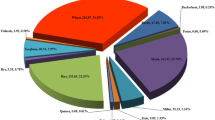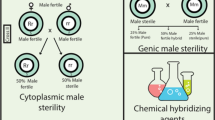Abstract
Hexaploid bread wheat was derived from a hybrid cross between a cultivated form of tetraploid Triticum wheat (female progenitor) and a wild diploid species, Aegilops tauschii Coss. (male progenitor). This cross produced a fertile triploid F1 hybrid that set hexaploid seeds. The identity of the female progenitor is unknown, but various cultivated tetraploid Triticum wheats exist today. Genetic and archaeological evidence suggests that durum wheat (T. turgidum ssp. durum) may be the female progenitor. In previous studies, however, F1 hybrids of durum wheat crossed with Ae. tauschii consistently had low levels of fertility. To establish an empirical basis for the theory of durum wheat being the female progenitor of bread wheat, we crossed a durum wheat cultivar that carries a gene for meiotic restitution with a line of Ae. tauschii. F1 hybrids were produced without using embryo rescue techniques. These triploid F1 hybrids were highly fertile and spontaneously set hexaploid F2 seeds at the average selfed seedset rate of 51.5%. To the best of our knowledge, this is the first example of the production of highly fertile F1 hybrids between durum wheat and Ae. tauschii. The F1 and F2 hybrids are both similar morphologically to bread wheat and have vigorous growth habits. Cytological analyses of F1 male gametogenesis showed that meiotic restitution is responsible for the high fertility of the triploid F1 hybrids. The implications of these findings for the origin of bread wheat are discussed.




Similar content being viewed by others
References
Araus JL, Slafer GA, Romagosa I, Molist M (2001) FOCUS: estimated wheat yields during the emergence of agriculture based on the carbon isotope discrimination of grains: evidence from a 10th millennium BP site on the Euphrates. J Archaeol Sci 28:341–350
Bushuk W, Kerber ER (1978) The role of Triticum carthlicum in the origin of bread wheat based on gliadin electrophoregrams. Can J Plant Sci 58:1019–1024
Dvorák J, Luo MC (2001) Evolution of free-threshing and hulled forms of Triticum aestivum: old problems and new tools. In: Caligari PDS, Brandham PE (eds) Wheat taxonomy: the legacy of John Percival. The Linnean Society of London, London, pp 127–136
Feldman M (2001) Origin of cultivated wheat. In: Bonjean AP, Angus WJ (eds) The world wheat book. Lavoisier, Paris, pp 3–56
Fukuda K, Sakamoto S (1992a) Studies on the factors controlling the formation of unreduced gametes in hybrids between tetraploid emmer wheats and Aegilops squarrosa L. Jpn J Breed 42:747–760
Fukuda K, Sakamoto S (1992b) Cytological studies on unreduced male gamete formation in hybrids between tetraploid emmer wheats and Aegilops squarrosa L. Jpn J Breed 42:255–266
Hillman G (1978) On the origins of domestic rye—Secale cereale: the finds from aceramic Can Hasan III in Turkey. Anatolian Stud 28:157–174
Jauhar PP (2003) Formation of 2n gametes in durum wheat haploids: sexual polyploidization. Euphytica 133:81–94
Jauhar PP, Dogramaci-Altuntepe M, Peterson TS, Almouslem AB (2000) Seedset on synthetic haploids of durum wheat: cytological and molecular investigations. Crop Sci 40:1742–1749
Kellogg EA (2003) What happens to genes in duplicated genomes. Proc Natl Acad Sci USA 100:4369–4371
Kerber ER, Bendelow VM (1977) The role of Triticum carthlicum in the origin of bread wheat based on comparative milling and baking properties. Can J Plant Sci 57:367–373
Kihara H (1944) Discovery of the DD-analyser, one of the ancestors of Triticum vulgare (abstr) (in Japanese). Agric Hortic 19:889–890
Kihara H, Lilienfeld F (1949) A new synthesized 6x-wheat. In: Proc 8th Int Congr Genet. Hereditas [Suppl]:307–319
Kihara H, Okamoto M, Ikegami M, Tabushi J, Suemoto H, Yamane Y (1950) Morphology and fertility of five new synthesized hexaploid wheats (in Japanese with English summary). Seiken Ziho 4:127–140
Kihara H, Yamashita K, Tanaka M (1965) Morphological, physiological, genetical and cytological studies in Aegilops and Triticum collected from Pakistan, Afghanistan and Iran. In: Yamashita K (ed) Results of the Kyoto University Scientific Expedition to the Karakoram and Hindukush, 1955, vol 1. Kyoto University, Kyoto, pp 1–118
Kuckuck H (1979) On the origin of Triticum carthlicum Neyski (=Triticum persicum Vav.). Wheat Inf Serv 50:1–5
Maan SS, Sasakuma T (1977) Fertility of amphihaploids in Triticinae. J Hered 68:87–94
Maan SS, Sasakuma T, Tsuji S (1980) Fertility of intergeneric hybrids in Triticinae. Seiken Ziho 29:78–86
MacKey J (1963) Species relationship in Triticum. In: MacKey J (ed) Proc 2nd Int Wheat Genet Symp. Genetics Institute, University of Lund, Sweden, pp 237–276
McFadden ES, Sears ER (1944) The artificial synthesis of Triticum spelta (abstr). Rec Genet Soc Am 13:26–27
Muramatsu M (1985) Spike type in two cultivars of Triticum dicoccum with the spelta gene q compared with the Q-bearing variety liguliforme. Jpn J Breed 35:255–267
Muramatsu M (1986) The vulgare super gene, Q: its universality in durum wheat and its phenotypic effects in tetraploid and hexaploid wheats. Can J Genet Cytol 28:30–41
Nishikawa K (1960) Hybrid lethality in crosses between emmer wheats and Aegilops squarrosa. I. Vitality of F1 hybrids between emmer wheats and Ae. squarrosa var. typica. Seiken Ziho 11:21–28
Okamoto M (1957) Asynaptic effect of chromosome V. Wheat Inf Serv 5:6
Riley R, Chapman V (1958) Genetic control of the cytologically diploid behaviour of hexaploid wheat. Nature 182:713–715
Riley R, Coucoli H, Chapman V (1967) Chromosomal interchanges and the phylogeny of wheat. Heredity 22:233–248
Salamini F, Özkan H, Brandolini A, Schäfer-Pregl R, Martin W (2002) Genetics and geography of wild cereal domestication in the Near East. Nat Rev Genet 3:429–441
Slageren MW van (1994) Wild wheats: a monograph of Aegilops L. and Amblyopyrum (Jaub. & Spach) Eig (Poaceae). Wageningen Agricultural University, Wageningen, pp 88–94
Tanaka M (1961) Newly synthesized amphidiploids from the hybrids, emmer wheats × Aegilops squarrosa varieties. Wheat Inf Serv 8:8
Xu SJ, Dong YS (1992) Fertility and meiotic mechanisms of hybrids between chromosome autoduplication tetraploid wheats and Aegilops species. Genome 35:379–384
Xu SJ, Joppa LR (1995) Mechanisms and inheritance of first division restitution in hybrids of wheat, rye, and Aegilops squarrosa. Genome 38:607–615
Xu SJ, Joppa LR (2000) First-division restitution in hybrids of Langdon durum disomic substitution lines with rye and Aegilops squarrosa. Plant Breed 119:233–241
Zhukovsky P (1923) “Persian wheat” – Triticum persicum Vav. in Transcaucasia (in Russian with English summary). Bull Appl Bot 13:45–55
Zohary D, Hopf M (2000) Domestication of Plants in the Old World, 3rd edn. Oxford University Press, New York, pp 51–58
Acknowledgements
We are grateful to S. Yokota for providing the seeds of Ae. tauschii YM9508 and to K. Tsunewaki for his valuable comments. This work was supported by a Grant-in-Aid (No. 14740412) from the Ministry of Education, Science, Sports, and Culture of Japan.
Author information
Authors and Affiliations
Corresponding author
Additional information
Communicated by F. Salamini
Rights and permissions
About this article
Cite this article
Matsuoka, Y., Nasuda, S. Durum wheat as a candidate for the unknown female progenitor of bread wheat: an empirical study with a highly fertile F1 hybrid with Aegilops tauschii Coss.. Theor Appl Genet 109, 1710–1717 (2004). https://doi.org/10.1007/s00122-004-1806-6
Received:
Accepted:
Published:
Issue Date:
DOI: https://doi.org/10.1007/s00122-004-1806-6




